by Ocean Robbins: In 1813, Englishman John Harris published Peter Piper’s Practical Principles of Plain and Perfect Pronunciation, which contained one tongue twister for each letter of the alphabet…
We are proud to announce a new partnership with John and Ocean Robbins and the Food Revolution to bring our readers Summits, Seminars and Masterclasses on health, nutrition and Earth-Conscious living.
Sign Up Today For the Healthy Brain Masterclass
Harris was partial to the letter P, as is evident not just from the title, but also from the book’s most famous nursery rhyme (“Peter Piper picked a peck of pickled Peppers”).
Most of the tongue twisters are frankly disappointing. But Peter Piper and his pickled peppers have been challenging child and adult tongues’ dexterity for centuries.
And do you know what else challenges our tongues? Those very peppers that Peter Piper picked.
While not all varieties bring the heat, some peppers can cause inflammation and extreme discomfort to any mucous membrane they touch. The active ingredient in peppers, capsaicin, actually fools the tongue’s temperature receptors into responding as if the pepper was burning hot, which produces the symptoms we associate with eating extremely spicy or “hot” foods.
You might not think that extreme pain, coughing, sweating, hyperventilation, crying, and rivers of snot would be sensations people would gladly experience, but it’s wise never to underestimate the allure of social media, and the human response to a challenge. From shows like Hot Ones in which famous people interview each other while eating progressively more incendiary chili-infused hors d’oeuvres, to the subculture devoted to breeding the world’s hottest peppers, it’s clear that mouth pain is a real turn-on for lots of people.
But peppers aren’t all about the heat. There are plenty of pepper varieties that provide flavor — and exceptional nutritional value — without setting off fire alarms in your mouth.
In this article, we’ll look at the range of peppers, from “mild as a child” (to coin a beginner-level tongue twister) to “one taste can literally stop your heart.” We’ll see that peppers across the spiciness continuum have enriched culinary traditions worldwide for centuries, and can help you add variety, color, and some level of spice to your meals, as well.
In the end, we may even find out how many pickled peppers Peter Piper actually picked!
Peppers Around the World

Chili peppers originated somewhere in South America, though researchers argue about the exact location, citing evidence for Brazil, Bolivia, Mexico, and around the Andes mountain range. Birds may be responsible for their seed dispersal since they are unaffected by the intense capsaicin that deters other animals from eating many varieties.
Humans have cultivated peppers for somewhere between 5,000 and 7,000 years, making them among the oldest cultivated plants known.
Various cultures and cuisines feature peppers of different shapes, colors, sizes, and degrees of heat. You’ll find peppers in Mexican, Thai, Eastern European, Korean, Chinese, Malaysian, South African, Italian, Hungarian, and Indian cooking.
Some cultures stick to sweet peppers like bell peppers, and others lean heavily on hot peppers to flavor popular dishes.
Peppers have also been used medicinally for centuries. The Mayans used chilis to treat asthma, coughs, and sore throats. And the Tukano people of the Amazon basin administered crushed chili peppers and water nasally to relieve hangovers. Other uses include putting crushed red pepper fruits on the feet to cure athlete’s foot fungus and curing snakebites by making a drink from boiled green peppers. And I say fruits because botanically, peppers are berries. But unlike most berries, their seeds aren’t embedded in the flesh (called the pericarp, if you want to get technical), but instead are found in what is called the placenta, that spongy white mass just below the stem (known as the calyx).
Hot Pepper Challenges
And then there’s the modern “hot pepper challenge” trend, in which people eat (and try to tolerate the pain of) some of the hottest peppers on the planet, as measured in Scoville units. In a recent Carolina Reaper challenge, the winner, who ate 22 of the little buggers in a minute, described his experience as follows: “Once I stopped eating, a horrible burning in my throat started. I started screaming because it helped alleviate the pain in my throat. Then the stomach cramps started kicking in.”
The world’s hottest pepper, the Dragon’s Breath, is thought to be too dangerous to ingest (so far nobody’s tried). Since its’ unveiling in 2017, it’s been shown under glass at flower shows (kind of like a doomsday device in a superhero movie), and studied for its potential to numb the skin of people who are allergic to pharmaceutical anesthetics. So it seems that peppers’ medicinal properties have not been lost to the ages.
Types of Peppers
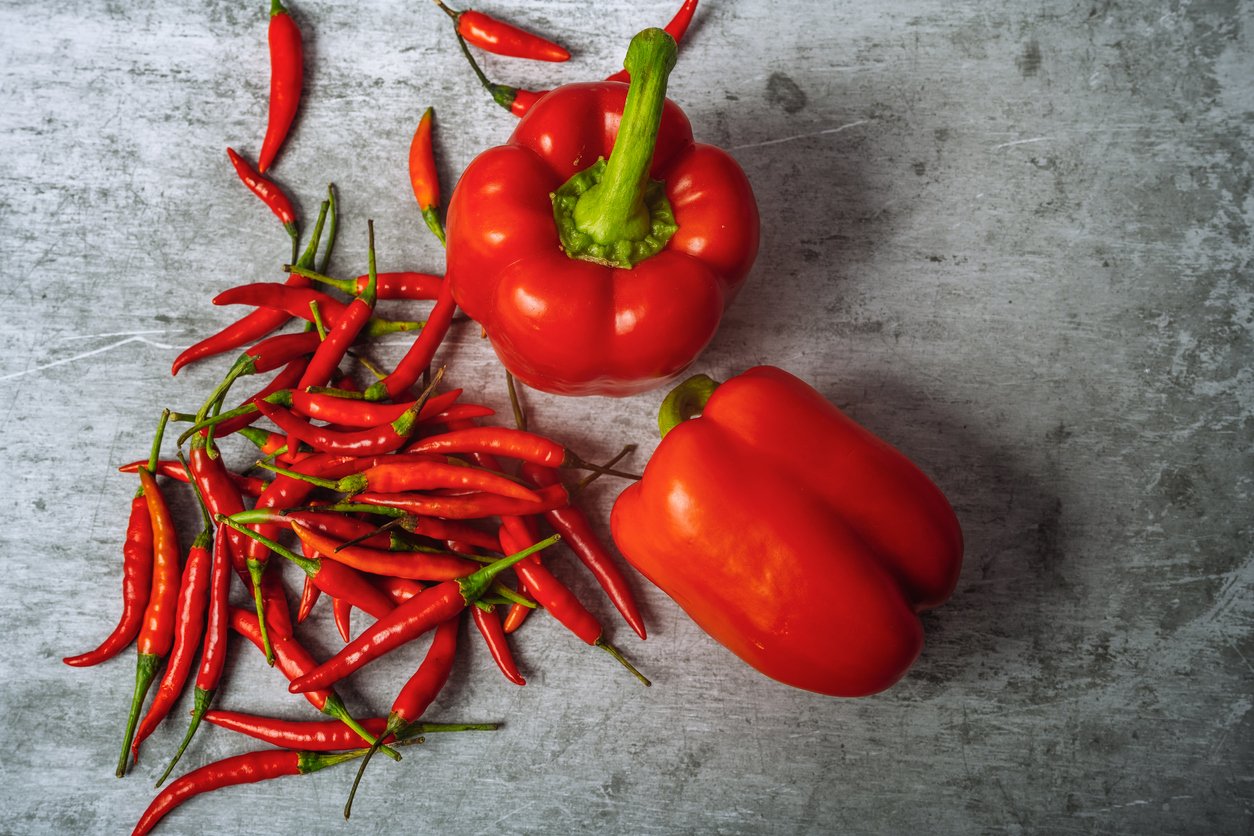
There are two main types of peppers — sweet and hot. But that’s a binary simplification of a continuum that’s measured, as we’ve seen, in Scoville Heat Units (SHUs). The scale, named for an ironically mildly-named Wilbur Scoville, a research scientist for a pharmaceutical company in the early 20th century, measures the pungency and heat of individual peppers.
Sweet Peppers
Landing low on the Scoville scale are Sweet peppers.
Sweet pepper varieties include:
- Bell peppers (median heat 0 SHUs)
- Mini sweet peppers (0)
- Shishito peppers (125)
- Banana peppers (250)
- Friggitello peppers (used to make pepperoncini: 300)
- Cubanelle peppers (550)
- Ancho peppers (1,500)
- Poblano peppers (1,500)
- Anaheim peppers (1,500)
- Cherry peppers (3,750)
Before you heedlessly bite into a shishito or Anaheim, be aware that different species of pepper can cross-pollinate. If you grow your peppers in a garden where mild and hot varieties coexist, you may find that some of the sweet peppers are quite a bit hotter than you might expect. Roughly 1 in 10 shishito peppers, for example, packs a lot more spice than average.
Hot Peppers
Hot peppers start where the sweet peppers leave off — you can begin to feel the burn at around 5,000 SHUs. The medium-hot varieties generally go up to 100,000 SHUs. Here’s a list of common hot peppers, along with their median Scoville scores:
- Jalapeño peppers (2,500–8,000 depending on variety)
- Serrano peppers (10,000–23,000)
- Habanero peppers (10,000–350,000)
- Cayenne peppers (30,000–50,000)
- Scotch bonnet peppers (100,000–300,000)
That last pepper, a featured ingredient in Jamaican cuisine, is about as hot as most people can tolerate without going into some kind of distress. You may cry and sweat and swear to be good from now on, but you probably won’t need to be airlifted to a medical center. The same cannot be said for the next category, the super hot peppers.
Super Hot Peppers
These are all modern inventions, created by pepper growers looking for bragging rights. And every few years, it seems, another grower develops a new super hot pepper variety that beats the previous world record for highest SHU.
The blistering hot peppers that have made their way into the food supply have names that sound like a parade of horror movie tropes, including ghost peppers, Trinidad Scorpions, and Carolina Reapers. This last is the current world record holder for hottest pepper, at 2.2 million SHU.
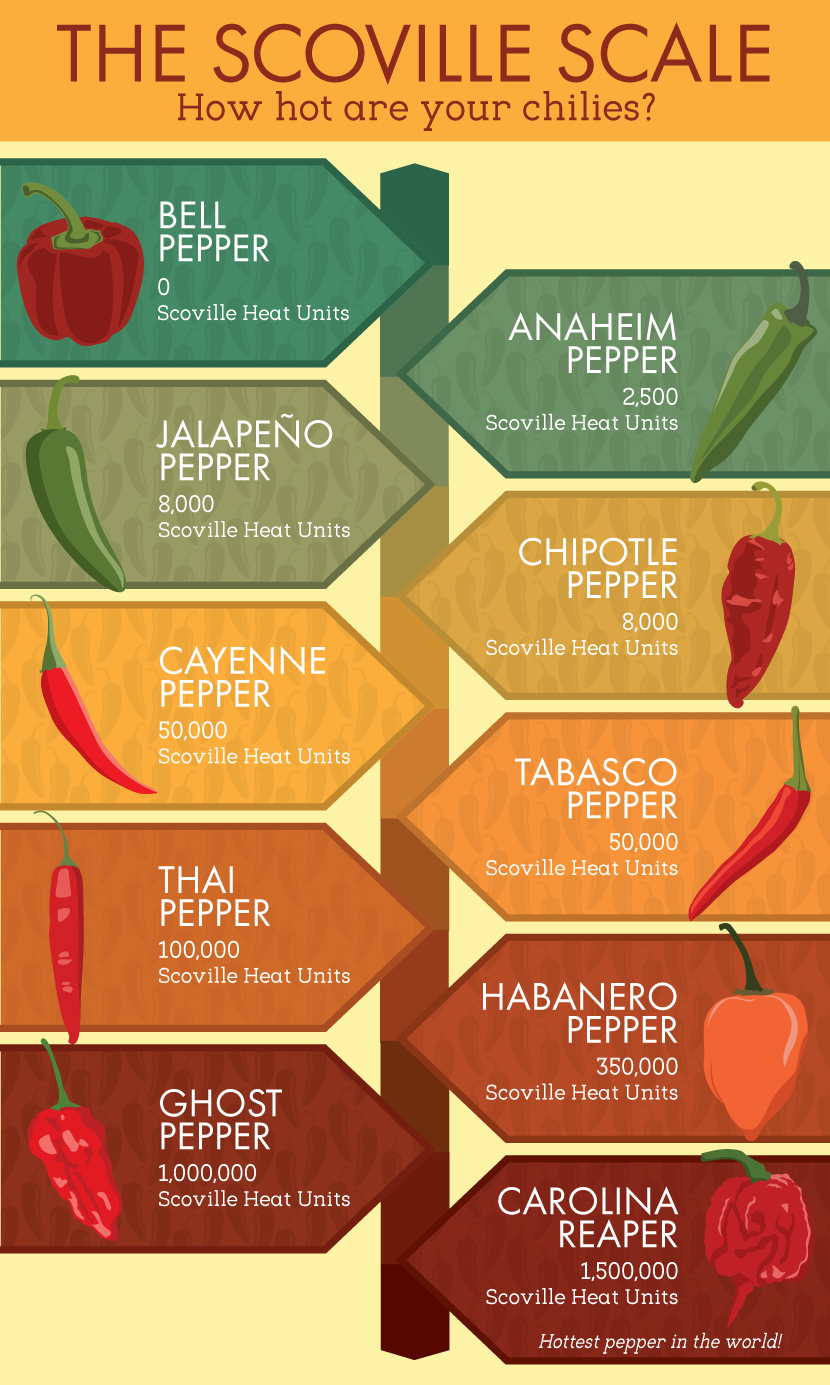
Source: Fix.com Blog
Pepper Colors and Sizes
Peppers vary in size and shape. Habaneros are small and rounded, while bell peppers tend to be large and plump. Cayenne peppers show up long and skinny.
Sweet and hot peppers also come in a rainbow of colors, including white, green, yellow, orange, red, purple, dark purple, black, and brown. Different varieties of pepper come in different colors, and many pepper varieties change hue as they move through their stages of ripeness.
Some breeds of the different colored bell peppers seen in grocery stores are the same type of bell pepper, just at different points of ripeness. They start out green, then turn yellow, orange, and finally red. Habaneros may also start out green and then turn red or orange. And some peppers, like the dramatic Hungarian black, start out a deep purple, almost black, before turning red.
Hot and Sweet Pepper Nutrition
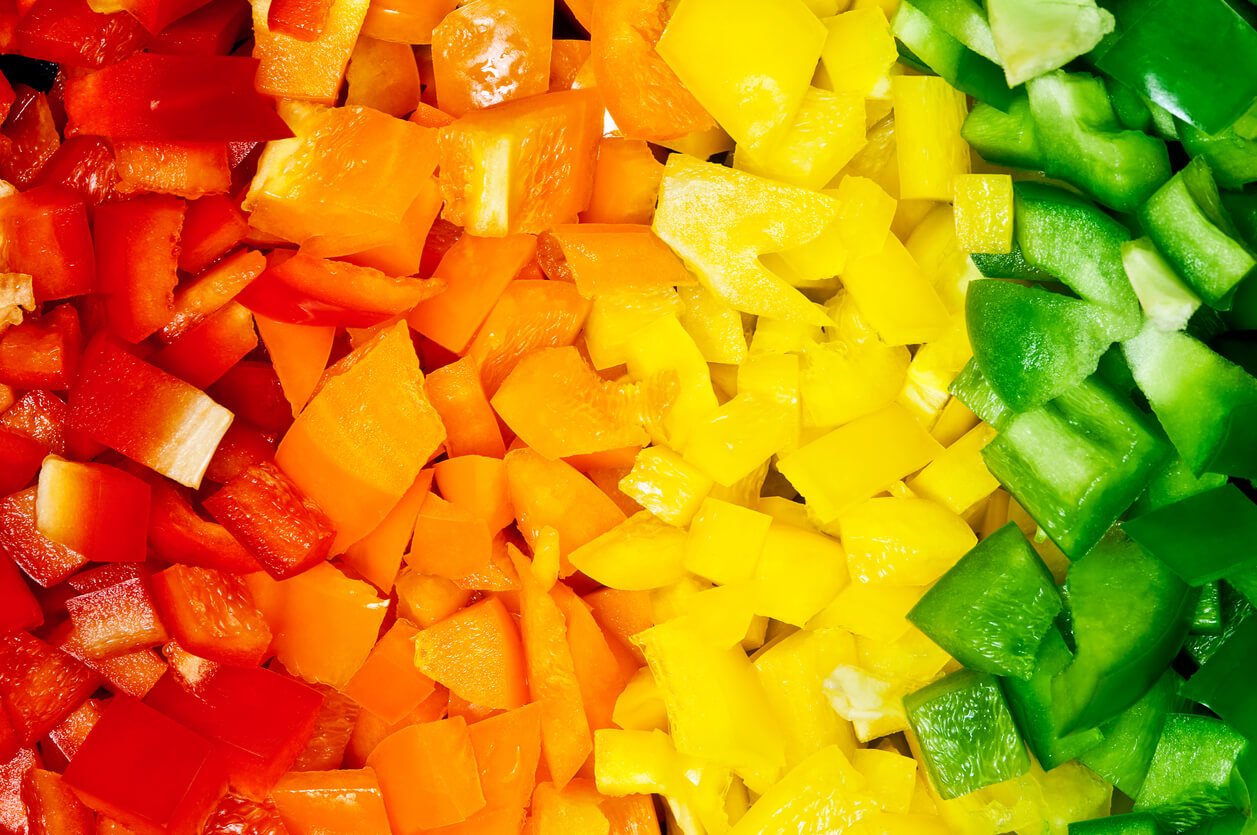
As you might expect from such a colorful family of fruits, sweet and hot peppers are nutritional powerhouses. They have some of the highest amounts of vitamin C of any produce, and the concentration increases as they ripen and change color. Green peppers have the lowest amount of vitamin C, while the reds, yellows, and oranges deliver much more. In fact, a red bell pepper has three times the vitamin C of a medium orange, the fruit that’s most often associated with the nutrient.
Peppers are high in other antioxidants and polyphenols, too. They rock two powerful carotenoids, lutein and zeaxanthin, which protect your body from free radicals and support eye health. Red and orange bell peppers are also rich sources of the vitamin A precursor beta-carotene.
Peppers are also great sources of fiber, vitamin E, vitamin K, and folate, as well as B6 and potassium. And hot peppers get their heat from the compound capsaicin, which is responsible for many of their health benefits (as you’ll see in the next section).
Benefits of Capsaicin-Containing Peppers
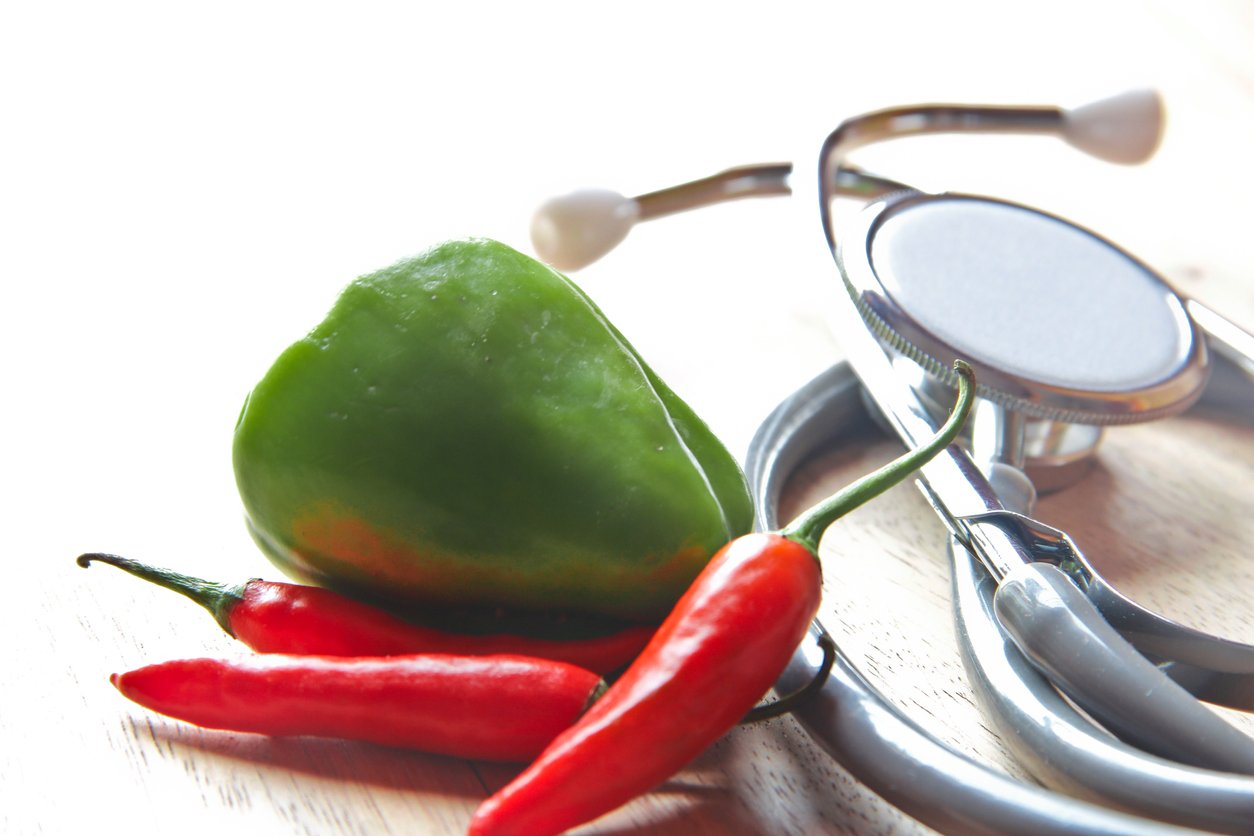
All peppers, regardless of the heat they deliver, provide many and varied health benefits. Both sweet and hot peppers contain some amount of capsaicin except for bell peppers, which contain none due to a recessive gene. Despite that fact, they still have their own set of health benefits due to being high in a number of antioxidants. (Find out more abouts antioxidants’ superpowers here.) But since most peppers contain capsaicin, we’re going to focus on the health benefits of the pepper component that brings both heat and health.
Capsaicin and Immune System Benefits
The capsaicin in peppers provides a boost to the immune system by killing the streptococcus bacteria, a major human pathogen. Medical researchers are also now studying the pepper compound’s potential role in treating antibiotic-resistant infections.
Capsaicin for Cancer
The capsaicin in peppers may combat cancer in several ways. It slows cell growth and division and can trigger apoptosis, a process by which damaged cells allow their destruction to benefit the larger organism. Capsaicin’s anticancer effect appears to be remarkably broad. It’s been seen in “adenocarcinoma, breast cancer, colon cancer, cutaneous cell carcinoma, esophageal carcinoma, gastric cancer, glioma, hepatocellular carcinoma, leukemia, multiple myeloma, nasopharyngeal carcinoma, non-small cell lung cancer, pancreatic cancer, prostate cancer, tongue cancer, and many others” — that’s quite a list!
Capsaicin for Pain Relief
You might think it’s weird that hot peppers, which can cause such pain, might also be used for analgesia (pain reduction). But there’s a lot of evidence that when properly dosed and timed, capsaicin can block some pain signals from the brain and provide relief to pain sufferers. It appears to bind to a particular receptor, TRPV1, causing immediate pain (burning) and then partially extinguishing the pain response by using up a compound called Substance P, which transmits the pain signals from your nerves to your brain.
Several studies have shown that high-dose topical applications of capsaicin (in a cream or gel) can relieve several different types of pain, including postsurgical, neuropathic, abdominal, and postherpetic neuralgia, which is the lasting pain that can follow a case of shingles.
Eating hot peppers appears to reduce sensitivity to pain — at least to the pain caused by eating hot peppers. You can test this for yourself by building up a tolerance for habaneros or Scotch bonnets. A bite that would have you sweating, writhing, and hiccuping on day one will hardly register after a few weeks of regular consumption. Just ask the people who participate in hot pepper eating competitions.
Capsaicin for Weight Loss
The fact that we refer to spicy peppers as “hot” provides a clue to their potential usefulness in weight loss. One of the main functions of fat in the body is to keep us warm when it’s cold outside. We “burn” fat the way a stove burns wood, producing heat in the process. Capsaicin seems to trigger what’s called brown fat thermogenesis, or the conversion of this particular form of fat into heat.
And interestingly enough, even capsaicin-free red peppers may have weight loss benefits, too. Studies have found that feeding people red peppers may lead to diminished appetite and reduced food intake. One study showed that a combination of a high carbohydrate diet and red pepper caused participants to burn more fat. They told researchers that the addition of red pepper made their meals feel “oilier,” so they were satiated with less.
Capsaicin Heart Benefits
Capsaicin may protect your cardiovascular system by stimulating the production of nitric oxide, which dilates blood vessels and helps your heart work more efficiently. One study found that people with ischemia (restricted blood supply to some area of the body) were able to exercise longer when they were outfitted with skin patches containing capsaicin.
Eating peppers, especially hot ones, can reduce high blood pressure, presumably via the same nitric oxide pathway. Capsaicin has also been shown to lower total cholesterol levels, reduce other lipids in blood, and support the integrity of the aorta, which is the biggest artery in your body. These mechanisms show up as better heart health — a 2022 meta-analysis reported “a statistically significant relative reduction in all-cause, cardiovascular, and cancer-related mortalities” in people who ate lots of peppers compared to those who hardly consumed any.
Pepper Side Effects and Considerations
Peppers can be awesome for your health, but there are some things to consider before you start training for the Hot Pepper Olympics (not a thing — yet).
Capsicum Allergy
Some people are allergic to bell peppers or other peppers, or to substances similar enough to trigger cross-reactivity. These can include celery, birch, and cedar pollen, and even latex, which may cause oral allergy syndrome after consuming peppers.
At the extreme end of exposure are workers in spice factories, who develop asthma at rates far exceeding the general population. In one study, chili pepper dust was found to be the most potent allergic trigger. It’s not just constant exposure to processed peppers that can lead to problems — in a survey of Dutch workers in a bell pepper greenhouse, fully half complained of allergic rhinitis (irritation and inflammation of the mucous membranes of the nose).
Nightshade Family Fears
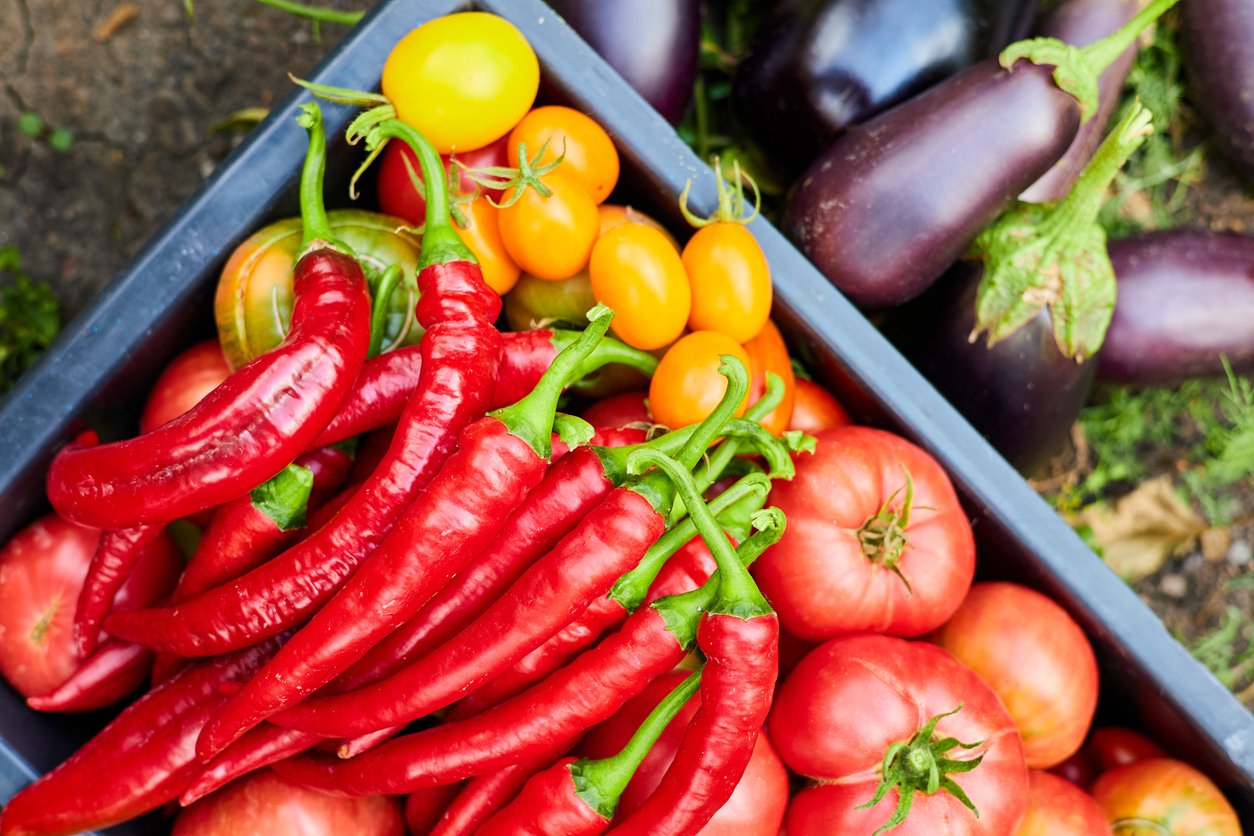
Peppers, along with many other popular foods like tomatoes and eggplants, are members of the frighteningly named nightshade family. To be fair, not all members of this family are friendly — the very toxic herb belladonna is also known as deadly nightshade (and, just as poetically, “devil’s cherries”). Fun fact: ladies at the court of Renaissance Venice applied belladonna eye drops to dilate their pupils, thus rendering themselves more attractive according to the standards of the day. Apparently, “just this side of comatose” was a good look in 16th-century Italy.
And lately, some folks have been urging us to avoid nightshades due to their lectin and alkaloid content, claiming that nightshade sensitivity is widespread and that eating peppers and other members of the Solanaceae family can cause all sorts of side effects and discomfort.
Now, if you eat peppers and feel terrible (or have an urge to get your portrait painted by Titian), perhaps you are experiencing some of those effects. But for the general population, there’s no real science to back up the alarmists’ claims. And as we’ve seen, nightshades like peppers are some of the healthiest foods on the planet. The irony is, the compounds that detractors claim are harmful may actually be the ones that promote health by challenging our bodies to respond in a positive manner.
For more on nightshades, see our article, here.
Peppers’ Pesticides

Unlike the largely unjustified fear of nightshades, concern over pesticides in peppers is warranted. Both bell and hot peppers are on the Environmental Working Group’s “Dirty Dozen,” which means they have more pesticides than most other produce tested. In 2022, they were the 7th most contaminated plant food.
You may therefore want to buy organic peppers, or even better, grow your own. If you have access only to conventionally grown peppers, you can remove most of the pesticide residues by washing them properly.
Hot Pepper Side Effects
We’ve already seen that hot peppers can be, well, very hot. The capsaicin can get you not just when you’re eating them — handling hot peppers can also produce very unpleasant skin sensations.
Touching hot peppers, especially the interior flesh and seeds, can cause a burning sensation wherever they make contact with your skin. You can mitigate this by wearing rubber gloves when working with hot and superhot peppers. And don’t touch your eyes or other sensitive body parts while, or right after, handling hot peppers. Seriously. Just don’t do it. Ever.
Peppers exceptionally high on the Scoville scale can cause irritation in your esophagus and digestive tract when you consume them, which can lead to nausea and vomiting. Here is a heart-warming, er, gut-warming story about a man who vomited so vigorously after eating a hamburger slathered with ghost pepper puree that he actually tore his esophagus.
My advice: when eating any kind of hot pepper or food made with hot peppers, start with a very tiny amount, especially if you’re not used to spicy foods. Despite the fact that capsaicin itself doesn’t cause damage, it can trick pain receptors in your mouth to announce loudly to your body that it’s about to die a painful death — and your body’s response to these fire alarms is what actually causes harm.
As part of your response to this stress, your body will produce endorphins to ease the pain, just as it might when you are running a grueling race on a hot summer day. Depending on how your body and mind interpret the sensations, you may be able to tolerate them and even get a pleasurable kick from them, or you might just feel overwhelming pain. The good news (if you’re into this sort of thing) is that you can train yourself to tolerate higher and higher Scoville peppers by challenging yourself in a slow and steady manner.
If you encounter a pepper that is too hot for you, don’t start drinking copious amounts of water (the guy who ate the ghost-pepper-topped hamburger downed six cups before the ambulance came). That will only make things worse. Instead, try a plant-based milk or other plant-based dairy product fortified with calcium. Alternatively, a starchy food, like bread, can also serve to neutralize the capsaicin.
And if you don’t like spicy food at all, don’t worry. Bell peppers still confer some wonderful health benefits, despite the absence of capsaicin.
How to Choose & Store Peppers

You can store whole, uncut peppers in a produce bag in your refrigerator for up to two weeks. Once you cut up a pepper, you can keep it refrigerated in an airtight container for up to 3 days. Wash your peppers just before using them.
If you grow your own peppers or belong to a CSA that has grown a glut of them, or you find a farmer who wants to unload a bushel or two, you can easily freeze peppers — they’ll last several months, or even longer. Just wash them, remove the stem and seeds, and cut them into whatever shapes you’ll want to cook later; spears, diced, etc. Heart-shaped pieces would be adorable, but probably a little too labor intensive for most people.
Then place your pepper pieces on a tray in the freezer. When they’re fully frozen, store them in freezer bags or freezer-safe containers. And do yourself a huge favor by labeling them with dates — that way you can avoid the “I have no idea what this is or what century it came from” syndrome that can result from overconfident reliance on memory.
Hot peppers are great dried, too. Most of them can be air-dried whole, although thinner and smaller ones tend to dry out faster and more completely. Simply hang them in the sun until they lose all their give and you can snap them into pieces. You can also use an oven or a dedicated dehydrator. (For our article on the pros, cons, and how-tos of dehydrating foods, click here.) Dried hot peppers can be even more intense than fresh, so apply the same precautions to handling them as you would a fresh Carolina Reaper.
And as fans of the letter P have known for centuries, you can also preserve peppers by pickling them. You can use them as ingredients or as condiments. Some versions are hot and spicy, while others impart a succulent and sweet flavor to dishes.
How to Use Peppers in Recipes
Peppers add a burst of flavor to whatever they’re used in. Sweet peppers can complement savory dishes when included in a recipe, while hot peppers are best used in moderation to flavor dishes so as not to overwhelm them.
Here are some ways to use peppers:
- Eat sweet peppers raw as a snack with a dip
- Stuff peppers with spreads or fillings like grains, legumes, and other veggies
- Use in grain bowls, tacos, and burritos
- Use in Asian dishes like stir-fries and noodle recipes
- Blend into spreads, dips, sauces (including hot sauces), and salsas
- Include in chilis and curries
- Use raw in salads, sandwiches, and wraps
You can also use peppers — including chili pepper, chipotle, cayenne, and paprika — as dried spices in many dishes, and foods like vegan bacon, pizza, soups and stews, and as a seasoning to add a bit of heat and smokiness to a variety of dishes.
Sweet and Hot Pepper Recipes
Sweet and hot peppers add vibrant flavors, bright colors, and quality nutrition to any dish that includes them.
Spice up your dinner party with tasty and satisfyingly rich Jalapeño Poppers.
If stuffed sweet peppers are your jam, then Lentil and Quinoa Stuffed Peppers are an elegant and delicious way to enjoy them — plus, their enticing aroma will permeate your home!
Black Bean Tostadas with Sweet Potatoes and Poblano Peppers offer the perfect balance of sweet, smoky, and a touch of heat in one easy-to-make, versatile, and oh-so-good-and-good-for-you dish.
And last but not least, Homemade Harissa is a delicious, pepper-centric condiment that is bursting with flavor and nutrient density. And, its heat is adjustable!
1. Jalapeño Poppers

Jalapeño Poppers are a delicious snack for any occasion, and this plant-based version surely will not disappoint. These delectable peppers are both crunchy and creamy, making them a satisfying snack or appetizer. The cashew cream offers a cool contrast to the heat and bite of the jalapeño. There is no shortage of flavor with these pop-in-your-mouth bites full of fun. Cashews, jalapeños, and chickpea bread crumbs are pure bliss. Not to mention, they are a good source of healthy fat, zinc, selenium, fiber, and vitamin C!
2. Lentil and Quinoa Stuffed Peppers
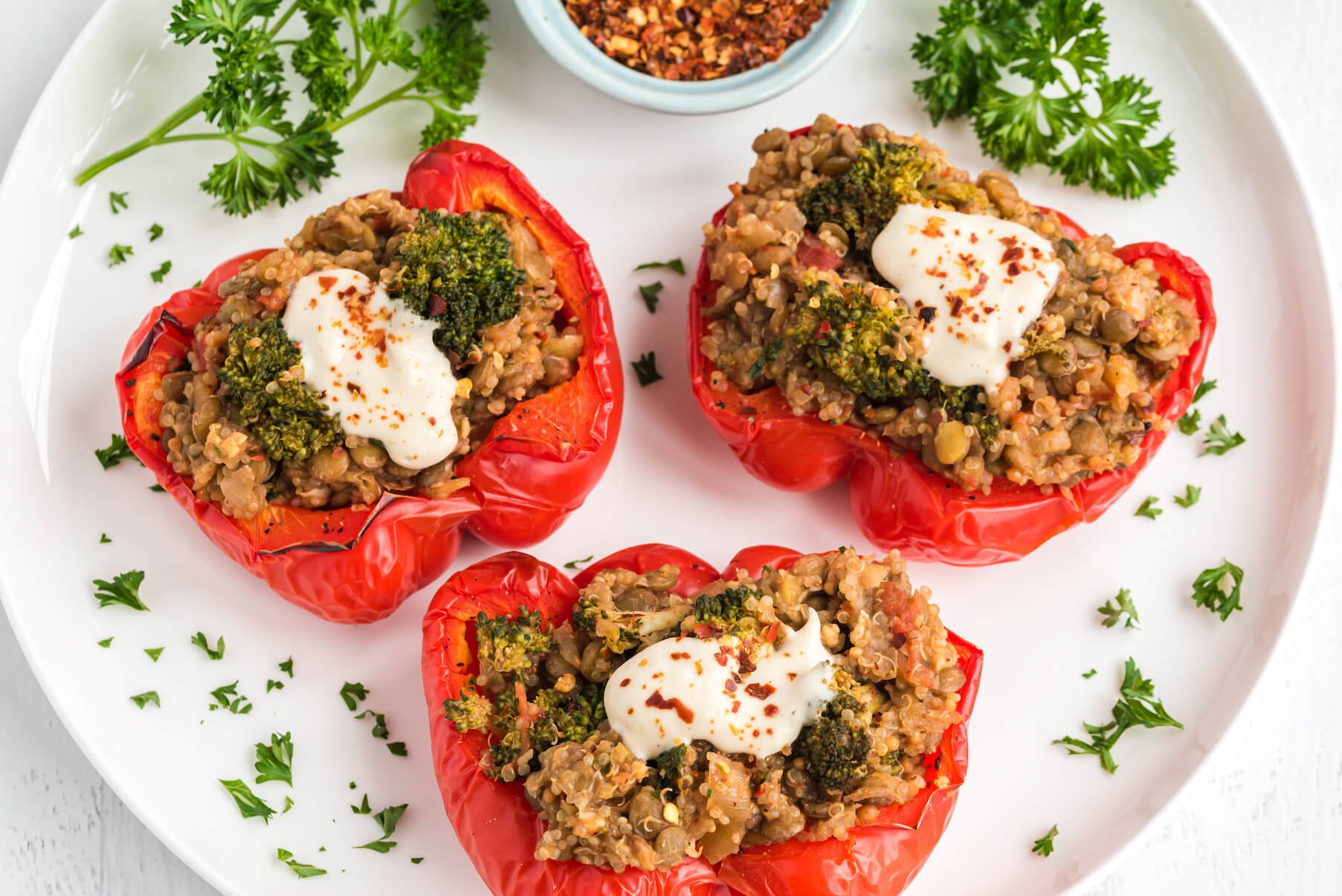
Red bell peppers make an ideal vehicle for a colorful and robust plant-based meal. This easy, anytime meal has plenty of fiber, protein, and phytonutrients from the lentils, quinoa, and vegetables. Plus, Lentil and Quinoa Stuffed Peppers have a generous amount of vitamin C from the broccoli, tomatoes, and peppers. We can’t think of a better way to enjoy these sweet beauties!
3. Black Bean Tostadas with Sweet Potatoes and Poblano Peppers
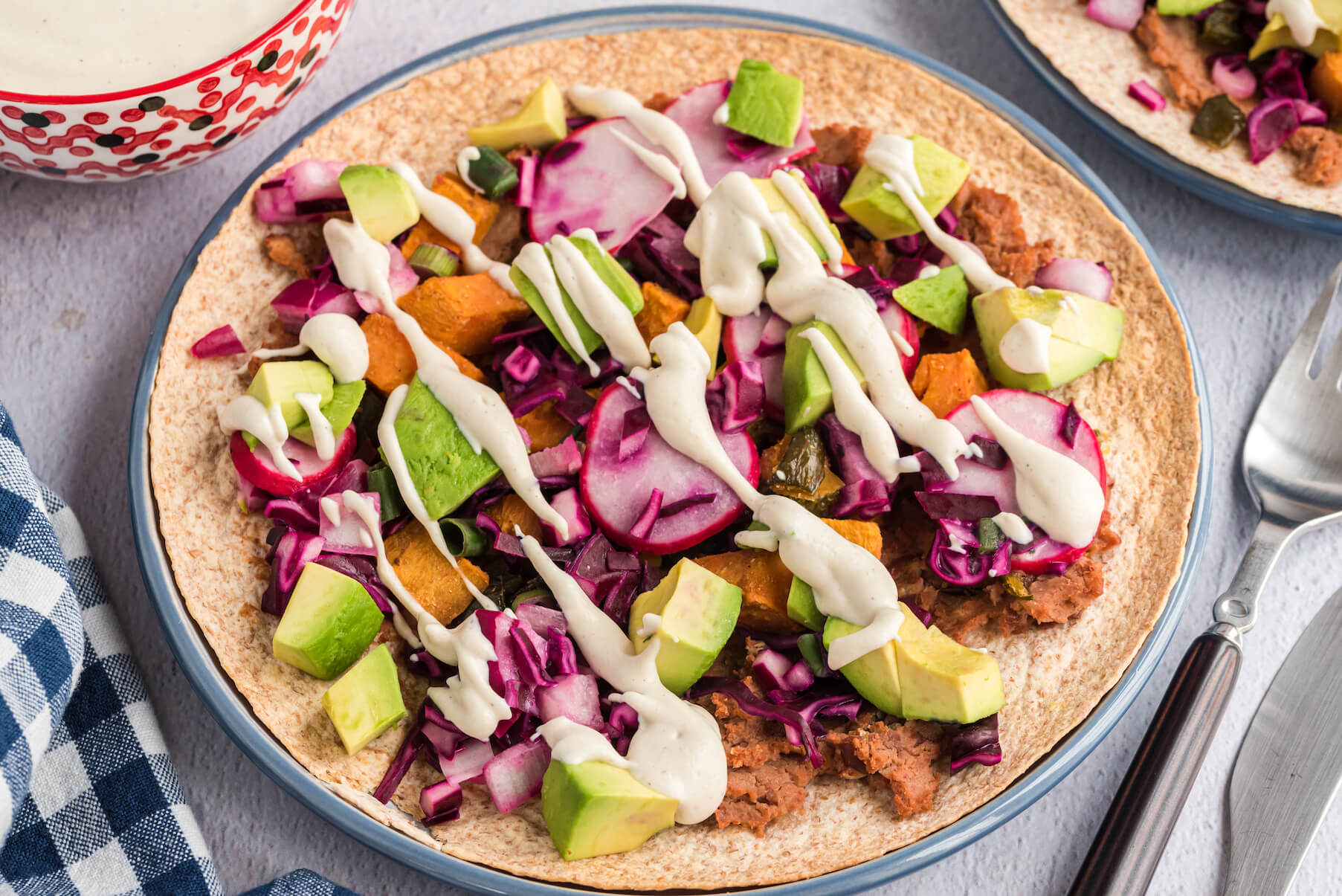
If poblano peppers are new to you, you’re in for a treat! These slightly spicy peppers are earthy, rich, and a bit acidic. Cooking the pepper brings out more smoky and savory undertones and adds the perfect bite to Black Bean Tostadas with Sweet Potato and Poblano Peppers. The combination of cabbage slaw, refried beans, and roasted veggies makes this one magnificent meal that you’ll want to share with your family and friends. Add your favorite plant-based cheese sauce to take it to the next level! And, if you want to skip the heat, then use your favorite colorful bell peppers in place of the poblanos — it will still be super scrumptious.
4. Homemade Harissa
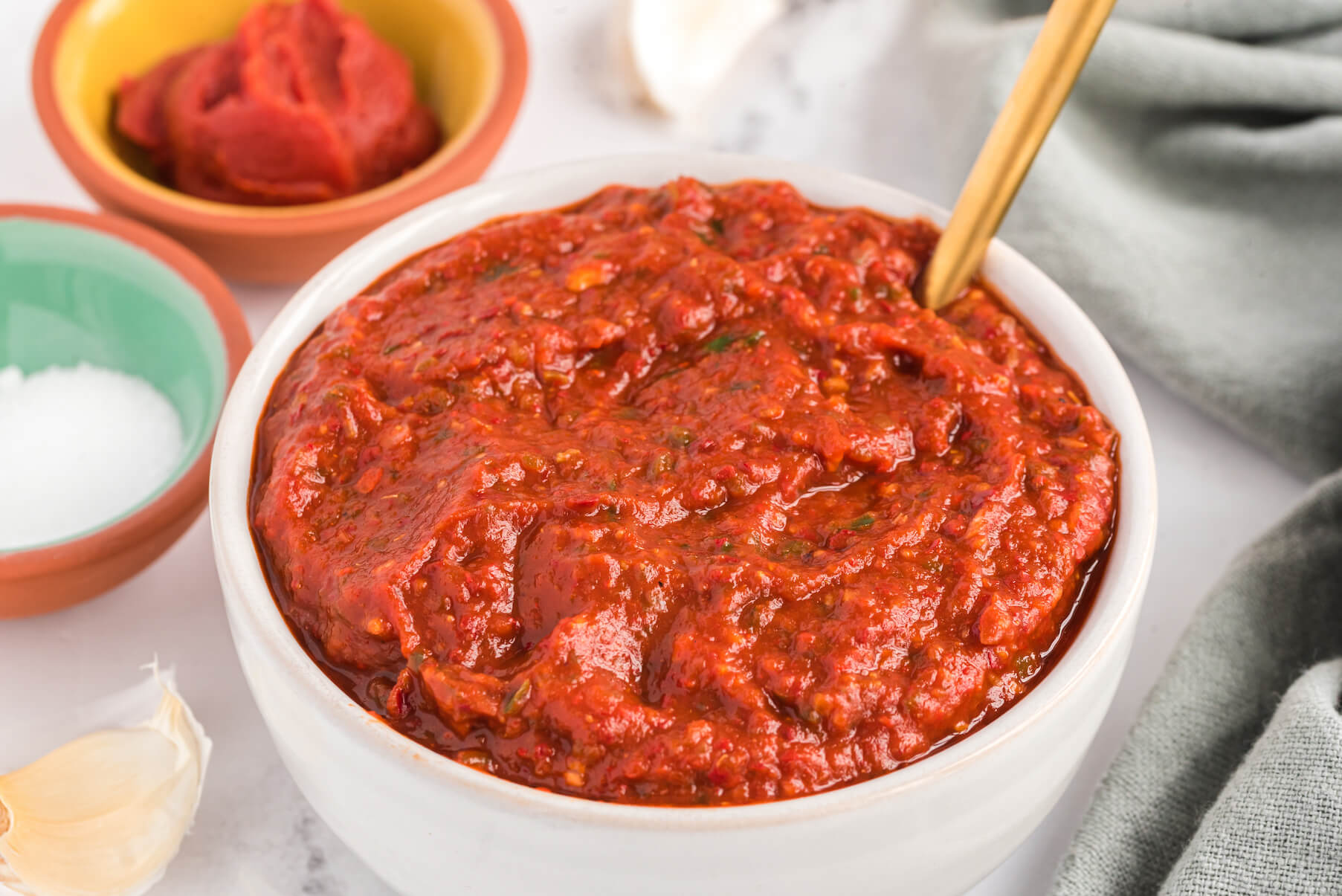
Sauces, dressings, and spreads can uplift just about any meal. And, when you make them with whole, plant-based foods, they can elevate the meal in both flavor and nutrition. Harissa, with origins in Tunisia and Algeria, is a smoky and peppery paste that can be hot — or not! For example, substitute more bell peppers for the pasilla peppers if you prefer no spice, or use the pasilla peppers if you like a little spice. And if you love it hot, then add a bit of cayenne pepper. Make harissa paste for the week and rub it on tofu, add it to soups, or mix it with yogurt to make a dressing or sauce.
Peppers Are Good for You!
Peppers are beloved worldwide for their remarkable nutritional and medicinal benefits, as well as their varied — and often intense — flavor profiles, colors, and heat levels. Whether sweet or hot, peppers have high amounts of vitamin C and other antioxidants that stave off oxidative stress in the body and help to prevent and manage chronic disease.
You can use sweet and hot peppers in a variety of savory and spicy dishes to add color and heat. And while there are some considerations when choosing and eating peppers (especially hot peppers), they are safe to eat for most people. If possible, though, choose organic, wash them well, or grow your own, to steer clear of pesticide exposure.
In conclusion, Popular Peppers Please your Palate by Providing Pizzazz to your Plate. And they’re really good for you, too!



















































